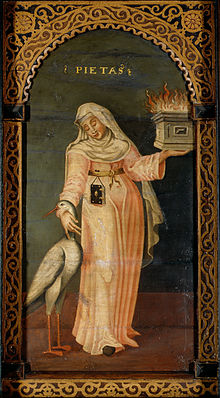虔誠
閱讀設定

(直譯 「虔誠」)
虔誠係一個人好尊重自己嘅宗教同埋靈性,喺好多文化同埋傳統入面都算係一種美德。一般虔誠都係用唔同嘅行為嚟到表達出嚟,每個文化都會唔一樣。
歷史
[編輯]喺西方文化,虔誠(拉丁文:Pietas)主要係一個羅馬帝國時代遺留落嚟嘅概念。喺當時,虔誠代表咗對神、國家、同埋父母嘅責任,係一件古羅馬社會非常之睇起嘅特徵[1][2]。
歐洲中世紀嘅聖師,聖多瑪斯亞奎那,曾經答過一條關於父母同仔女嘅關係嘅問題,而佢就用咗西塞羅講嘅概念:「虔誠就係提供責任同埋敬意;“責任”(duty) 即係對一個人嘅服務,而“敬意”(homage) 就係對佢嘅尊重同榮譽」[3]。 孝係儒家入面最基本嘅倫理,同虔誠嘅概念非常似[4]。喺中華文化入面,呢個被認為係最基本嘅人際關係[5]。
攷
[編輯]- ↑ 西塞羅. "I.116". Nature of the Gods.
- ↑ 西塞羅. "II.66". On Rhetorical Invention.
- ↑ 聖多瑪斯亞奎那. "Secunda Secundae". Summa Theologiae.
- ↑ Chang, Wonsuk; Kalmanson, Leah (2010). Confucianism in Context: Classic Philosophy and Contemporary Issues, East Asia and Beyond. SUNY Press. p. 68. ISBN 978-1-4384-3191-8.
- ↑ Willard, Dallas (2000). "Christ-Centered Piety". Where Shall My Wond'ring Soul Begin?: The Landscape of Evangelical Piety and Thought. Grand Rapids, Mich.: Wm. B. Eerdmans Publishing Co. pp. 27–36.
